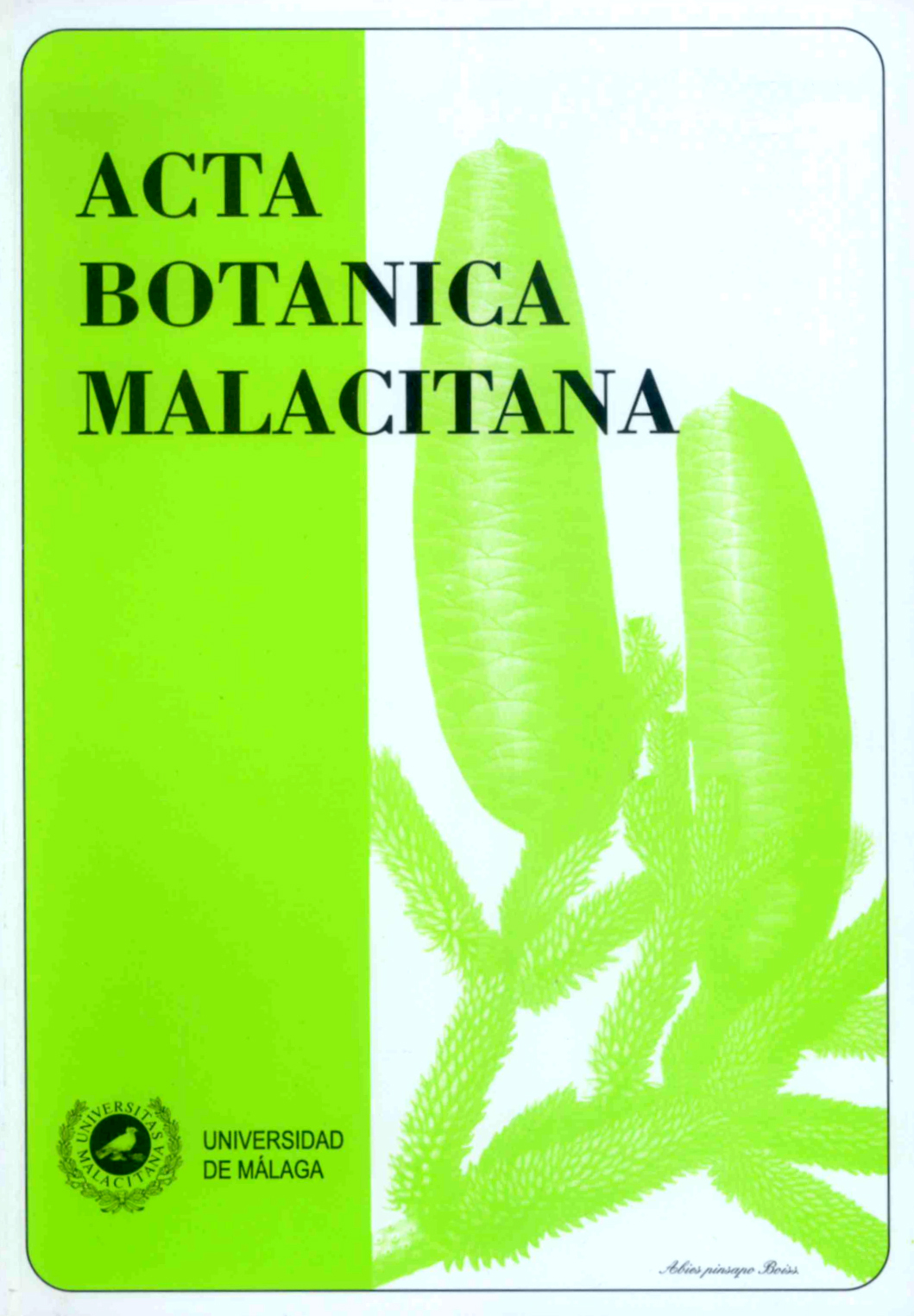Vegetación de la Reserva de la Biosfera Sierra de las Nieves: Río Grande y Sierras Prieta y Blanquilla (Málaga, España). Vegetation of the biosphere reserve Sierra de las Nieves: Grande river and Prieta-Blanquilla mountains (Malaga, Spain)
DOI:
https://doi.org/10.24310/abm.v37i0.2675Abstract
Español. Se ha realizado un estudio florístico, fitocenológico y fitogeográfico de dos zonas de la Reserva de la Biosfera Sierra de las Nieves y su Entorno (sectores Rondeño y MalacitanoAxarquiense, provincia Bética, Región Mediterránea): el macizo montañoso de Prieta-Blanquilla y el Río Grande. Bioclimáticamente se caracterizan por la presencia de los pisos termomediterráneo seco-subhúmedo, mesomediterráneo seco - subhúmedo - húmedo y supramediterráneo húmedo. Se comentan algunos táxones de interés por su grado de amenaza (ej. Carduus rivasgodayanus), por estar protegidos (ej. Sarcocapnos baetica subsp. baetica) o por ser endemismos rondeños (ej. Linaria clementei) o muy escasos (ej. Teucrium reverchonii). El territorio presenta una muy elevada cantidad de sintaxones (72) si tenemos en cuenta su pequeña extensión. De estos sintaxones destacan algunas novedades como matorrales endémicos con bolinas (Cytiso plumosi-Ulicetum baetici genistetosum umbellatae) o lastonares endémicos de estas sierras (Festuco scariosae-Helictotrichetum arundani festucetosum capillifoliae). Se han catalogado 15 series de vegetación: 6 de tipo climatófilo caracterizadas por vegetación climácica de árboles planifolios, perennifolios o marcescentes (Quercus suber, Quercus rotundifolia, Quercus faginea, Acer granatensis), 2 edafoxerófilas de sabinares dolomitícolas (Juniperus phoenicea) o coscojares serpentinícolas (Quercus coccifera) y 7 edafohidrófilas con vegetación climácica dominada por árboles caducifolios (Populus alba, Fraxinus angustifolia, Salix pedicellata, Salix purpurea) o arbustos (Nerium oleander) de riberas o niveles freáticos. La vegetación de complejos topogénicos se desarrolla en roquedos (Saxifraga globulifera, Sarcocapnos baetica, Stachys circinata) y los edafogénicos en fuentes y tobas (Rubus ulmifolius, Scirpoides holoschoenus, Eupatorium cannabinum) o como prados higrófilos (Festuca arundinacea, Juncus buffonius, Juncus inflexus).
English. Flora, vegetation and phytogeography have been studied in two areas of the Biosphere Reserve “Sierra de las Nieves y su Entorno” (Rondeño and Malacitano-Axarquiense phytogeographical sectors, Betica province, Mediterranean region): Prieta and Blanquilla mountains and Grande river. Three bioclimatic belts have been identified: thermomediterranean dry-subhumid, mesomediterranean dry - subhumid - humid and supramediterranean humid. Some interesting taxa are commented because of their endangered status (eg. Carduus rivasgodayanus), protected species (eg. Sarcocapnos baetica subsp. baetica) endemics (Linaria clementei) or very scarce populations (ej. Teucrium reverchonii). The studied region shows a very high amount of syntaxa (72) if we take into account its small area. Among the syntaxa some are new: endemic shrublands (Cytiso plumosi-Ulicetum baetici genistetosum umbellatae) and high mountain endemic pastures (Festuco scariosae-Helictotrichetum arundani festucetosum capillifoliae). 15 vegetation series have been catalogued: 6 series are climatophyllous and characterised by sclerophyll or marcescent broad-leaved trees, (Quercus suber, Quercus rotundifolia, Quercus faginea, Acer granatensis); 2 edaphoxerophyllic series characterised by dolomitic junipers (Juniperus phoenicea) or serpentinic kermes oak (Quercus coccifera); 7 series are edaphohydrophyllic and characterised by deciduous trees (Populus alba, Fraxinus angustifolia, Salix pedicellata, Salix purpurea) or tall shrubs (Nerium oleander) in riversides and banks. Other kind of vegetation develops in biotopes as rocks (Saxifraga globulifera, Sarcocapnos baetica, Stachys circinata), springs and damp soils (Rubus ulmifolius, Scirpoides holoschoenus, Eupatorium cannabinum) or pastures on wet soils (Festuca arundinacea, Juncus buffonius, Juncus inflexus).
Downloads
Metrics
Downloads
Published
How to Cite
Issue
Section
License
Those authors who publish in this journal accept the following terms:
a. The authors will retain their copyrights and guarantee the journal the right of first publication of their work, which will be simultaneously subject to the Creative Commons Attribution-Non-commercial 4.0 license whose full text can be found at <http: // creative commons .org / licenses / by-nc / 4.0> that allows third parties to share the work as long as its author and its first publication are indicated, and as long as it is not for commercial purposes.
b. Authors may adopt other non-exclusive licensing agreements for the distribution of the version of the published paper (e.g., deposit it in an institutional telematic file or publish it in a monographic volume) provided that the initial publication in this journal be indicated.
c. Authors are allowed and recommended to disseminate their work through the Internet (e.g., in institutional telematic archives or on their websites) before and during the submission process, which can produce interesting exchanges and increase citations of the published work. (See The effect of open access)







1.png)
